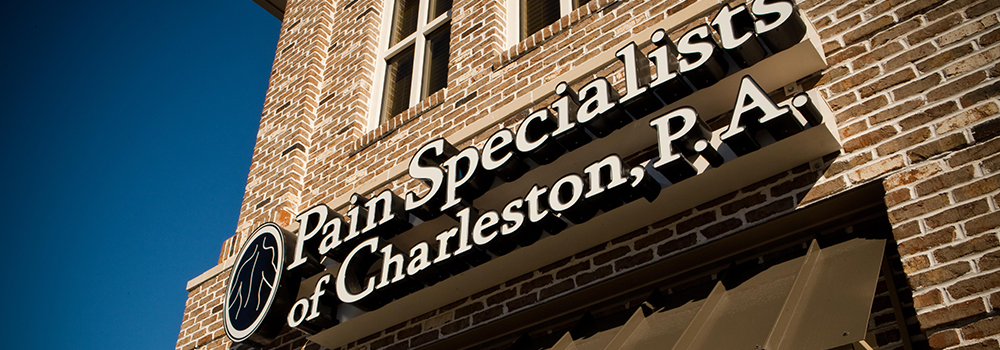Medial Branch Block

A medial branch block (MBB) is a procedure used to diagnose or treat back, neck, shoulder, hip, or buttock pain. After numbing the skin with a small needle, your doctor will inject the anesthetic near the medial branch nerves. In successful procedures, more than half of patients enjoy at least 80% pain improvement.
Here at Pain Specialists of Charleston, our board-certified pain management physicians will examine, diagnose, and treat the root cause of your pain in order to help you reclaim your quality of life. Our thorough approach is about more than treating your symptoms – and we remain dedicated to delivering relief when you need it most.
Our pain management clinic is open five days a week. We are currently accepting new patients, so schedule your appointment with us today. Plus, there’s no referral needed!
No Referral Needed — Same Day Appointments — Accepting New Patients
Request Appointment | Meet Pain Doctors | Contact Us | Visit Us
WHAT CAN IT TREAT
- Back pain (most common use)
- Buttocks pain
- Degenerative spondylolisthesis
- Facet joint osteoarthritis
- Hip pain
- Neck pain
- Rheumatoid arthritis
- Scoliosis
- Shoulder pain
- Spinal osteoarthritis
Medial branch block injections are considered safe and are tolerated well by most patients. While serious complications are rare, there are potential risks with any injection procedure. For medial branch blocks, the side effects are usually minor and temporary. Consult your physician to learn more about managing unpleasant symptoms, if needed.
WHAT TO EXPECT BEFORE THE PROCEDURE
Initial Assessment
- Overall health review (medical conditions, current medications, allergies, etc.)
- Physical exam to identify the spinal area causing pain
- Imaging tests or labs to check for any joint damage or inflammation
Specialist Consult
- Pain management doctors, anesthesiologists, or spine specialists may assess your condition and perform the medial branch block.
Medication Adjustments
- For patients taking blood-thinning medications, your pain management physician may recommend adjusting your dose or stopping it two to seven days before the procedure.
- Be sure to consult your doctor before making any medication changes.
DAY OF THE PROCEDURE
Setting and Duration
Because sedatives may alter results, patients will remain awake and alert throughout the procedure, usually lasting about 15 to 30 minutes. If needed, a calming medication may be offered.
Procedure Steps
- Preparation
- Lie face-down on the procedure table.
- A local anesthetic is injected to numb the skin and tissues near the facet joint.
- Needle Placement
- The doctor uses x-ray (fluoroscopy) or ultrasound imaging to position two thin needles near the medial branch nerves, focused on targeting the facet joint.
- In some cases, a single-needle technique may be used.
- Medication Injection
- The doctor will then slowly inject the local anesthetic onto each medial branch nerve.
AFTER THE PROCEDURE
Observation Period
- You’ll be observed for approximately 30 minutes after the injection.
- Check for relief by making small movements that typically cause pain.
Pain Relief Monitoring
- If the facet joint is to blame, pain relief may start within two to six hours.
- To be considered a candidate for further treatments, you must experience at least 50% improvement in pain during this period.
Pain Journal
- Document any changes in symptoms on the day of the injection to help assess the procedure’s effectiveness.
Medical Consult
- Talk to your specialist or pain management team with any questions or concerns.
WHEN SHOULD I SEE A PAIN PHYSICIAN?
If you’re experiencing chronic pain near the spine, a qualified pain management physician can help you find relief. At Pain Specialists of Charleston, our board-certified physicians will examine, diagnose, and treat the root cause of your pain to restore your quality of life.
Our pain management clinic is open five days a week. We are accepting new patients, so schedule your appointment with us today. No referral needed!
CONDITIONS WE MANAGE
- KNEE PAIN
- CHEST PAIN
- SHOULDER PAIN
- BACK PAIN
- HIP PAIN
- NECK PAIN
- ELBOW PAIN
- FOOT PAIN
- WRIST PAIN
- & MORE!
TREATMENT WE OFFER
At Pain Specialists of Charleston, our board-certified team offers pain management treatment in the form of:
- Epidural Steroid Injection including cervical, thoracic, and lumbar injections
- Joint Injections including knee, shoulder, and hip injections
- Caudal Epidural Injection
- Hip Joint Injection
- Lumbar Sympathetic Block
- Facet Joint Injection
- Medial Branch Block
- Radiofrequency Ablation (Rhizotomy)
- Sacroiliac Joint Injection
- Discography
- Neurostimulation, also known as Spinal Cord Stimulation
- Stellate Ganglion Block
- Transforaminal Selective Nerve Root Block Injection
- Medical Massage Therapy
- Clinical Trials
- …and MORE!

ABOUT PAIN SPECIALISTS OF CHARLESTON
At Pain Specialists of Charleston, our mission is to provide you with relief from your chronic pain through the latest, most innovative pain management treatments available. Whether you’re suffering from back pain, whiplash, or anything in between, we can help you get back to feeling like yourself once again.
Plus, no referral is necessary!
At our pain management clinic, our experienced team approaches your pain through a variety of services to best meet your needs. This includes anesthesiology, neurology, psychology, and nursing. Our providers believe in collaborating with your healthcare team – your primary care physician, specialists, chiropractor, physical therapist, and especially you, the patient, to bring you the care you need.
Our private practice is powered by a talented, carefully selected leadership team.
No Referral Needed — Same Day Appointments — Accepting New Patients
Request Appointment | Meet Pain Doctors | Contact Us | Visit Us
MEET DOCTOR EDWARD M. TAVEL, JR., MD
- Over 20+ Years of Specialty Training
- Double-Board Certified in Anesthesiology and Pain Management
AWARDS & ASSOCIATIONS

AS SEEN ON

FAQs
Who should not get medial branch blocks?
Medial branch blocks are not recommended for people with the following conditions:
- Active systemic infection
- Local infection around the procedure site
- Bleeding disorders
- Pregnancy
Be sure to mention any known allergies or drug sensitivities to your doctor. Alternative medications or treatments may be available to provide relief.
How painful are medial branch blocks?
A medial branch block is considered minimally invasive and is well tolerated by most patients. Little to no pain can be expected post-procedure, thanks to the local anesthetic injected into the spine. Before the anesthetic numbs the area, this injection may feel like a slight pinch and burn.
How will I feel after the block injection?
Patients can expect an immediate improvement in symptoms due to the local anesthetic but be sure to monitor your condition for the rest of the day. When utilized, the steroid takes about two to three days to take effect.
Some tenderness may be experienced at the injection site for a couple of days after the procedure. An ice pack and over-the-counter medication can be used to manage any discomfort.
Are you sedated for facet injections?
Patients may choose whether to receive sedation for their procedure. Because a medial branch block is a non-surgical treatment, you can return to work and your normal activities on the same day. To learn more, speak with your pain management physician about your sedation options.
Are medial branch blocks safe?
A medial branch block is a relatively straightforward, safe procedure. While it is a minimally invasive, non-surgical treatment, serious complications may occur – like infection, nerve injury, tissue damage, and more.
Are medial branch blocks worth it?
Medial branch blocks can provide much-needed relief for months. In fact, more than half of patients experience at least 80% pain relief after a successful procedure. Plus, the diagnostic data received is used to create a treatment plan.
What is the difference between a medial branch block and facet joint injection?
The injection site varies between the two, as does the primary purpose. A facet block is an injection of local anesthetic and steroids into a joint in the spine. A medial branch block involves a medication injection as well, placed outside the joint space near the nerve that supplies the joint called the medial branch. Note that a steroid may or may not be used).
Multiple studies have revealed significant pain reduction in patients with spinal pain. More than half of the patients experience at least 80% improvement in pain following a successful medial branch block. If two medial branch blocks independently confirm facet joint pain at the same spinal level, there is about a 60% chance of achieving lasting pain relief.
Can I return to normal daily activity after a medial branch block?
Patients are usually able to resume their normal activities – like working, driving, etc. – within a few days. Some patients even returned to their typical routine the same day as a medial branch block procedure. To prevent injury and reduce your risk of complications, refrain from engaging in activities that require significant physical effort.
How long do the results last?
The results of a medial branch block can last up to a week. To avoid false-positive (placebo) responses, we recommend that patients receive a second medial branch block procedure two to three weeks after the first.
How common are complications after medial branch block?
For most patients, medial branch block injections are perfectly safe. Side effects, if any, are usually minor and don’t last long. Talk to your pain management physician if you experience any side effects following your procedure.
What is the next step if a medial branch block doesn’t offer enough pain relief?
If you are still experiencing pain, your doctor will likely perform additional tests to determine the cause of the pain. Tests include MRIs, bone scans, or nerve tests. An underlying nerve condition, disc issue, or spinal stenosis may be to blame. As your physician seeks a definitive diagnosis, you may continue to manage pain through medication, physical therapy, and lifestyle changes.
At Pain Specialists Charleston, we offer board-certified physicians in anesthesiology, neurology, psychology, and nursing. Our team will perform a full exam to accurately diagnose and treat your condition – and help you find relief!
What is a medial branch nerve block?
A medial branch nerve block is a minimally invasive procedure that injects a small amount of local anesthetic near the medial branch nerves. These small nerves near the facet joints of the spine are responsible for transporting pain signals from the joints to the brain. The injection aims to block the pain signals that travel from the medial branch nerves to the brain, producing targeted pain relief.

